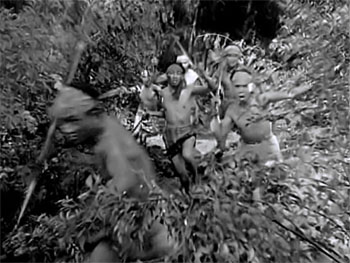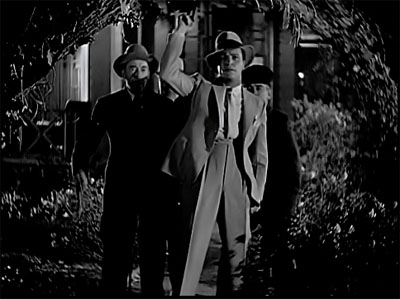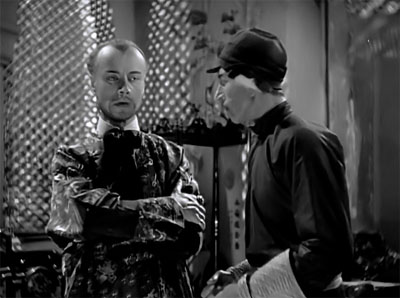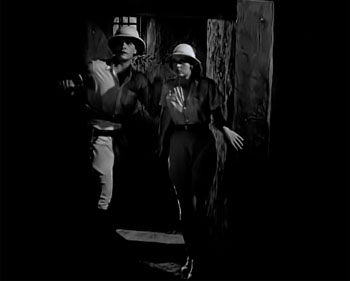
Universal, 12 Chapters, 1933. Starring Evalyn Knapp, Robert Allen, James Durkin, John Davidson, Frank Lackteen, Sonny Ray.
The Perils of Pauline–which has no connection to the famous silent chapterplay of that name outside of its title–begins, fairly uniquely for a serial, in media res. The action opens in a beleaguered Chinese city being bombed by rebels, where Dr. Hargraves (James Durkin), his daughter Pauline (Evalyn Knapp) and Hargraves’ cowardly secretary Dodge (Sonny Ray) are searching for an ancient Chinese disk with a secret formula for a devastating “invisible gas” engraved on it. Hargraves, who was told of this formula by an old Chinese priest named Confu, wants to acquire it before Eurasian scientist and would-be world ruler Dr. Bashan (John Davidson) does, but Bashan and his henchman Fang (Frank Lackteen) are close on his heels. Railroad engineer Bob Warde (Robert Allen), out of work due to the revolution, comes to Pauline’s rescue when she is ambushed by Bashan’s men in the streets, and thereafter joins the group of adventurers. After Pauline finds the first half of the disk in a Chinese temple, the Hargraves group sets off on a round-the-world trip in search of the second half, journeying from Borneo to Singapore to India and finally winding up in New York City–with Bashan still in hot pursuit.
Perils of Pauline has held a very low reputation among serial fans for many years, but is now enjoying something of a rehabilitation after being made available in an excellent DVD print by VCI Home Video Entertainment. Pauline certainly doesn’t deserve its reputation as one of Universal’s worst, but at the same time it’s not one of the studio’s best. Its principal assets are a strong cast and an impressive variety of locales that are enhanced by a judicious blend of stock footage and convincing sets. Universal’s superior budgets are noticeable in many of the serial’s exotic sequences–particularly in the Chinese street scenes, which are crowded with extras, and during the believably humid and oppressive-looking jungle trek.


Above: Hargraves and Dodge wind through the suitably crowded Chinese streets at left, while a band of savages charges through the suitably thick Borneo jungles at right
The studio’s castle and tomb sets from the Frankenstein films and The Mummy are also used to excellent effect during the Hargraves party’s exploration of various tombs and temples. I like the writers’ boldness in explaining away the use of Egyptian idols–leftovers from The Mummy–in the Borneo temple sequence: Pauline exclaims, “Why, these are gods of ancient Egypt! What are they doing here in Borneo?” to which Bob Warde simply answers, “I don’t know”–leaving a nice mystery of the ancient world for Dr. Barry Fell or Thor Heyerdahl to solve.

Above: Pauline and Bob in the Borneo temple.
Unfortunately, Pauline’s globe-trotting plot and stronger-than-average atmosphere–not to mention its use of the most formidable MacGuffin in any sound serial from the early 1930s–also helps to highlight its weaknesses, weaknesses shared by most of its Universal contemporaries but made more noticeable by Pauline’s greater scope. Like The Lost Special, Gordon of Ghost City, Tailspin Tommy, and other early Universals, Pauline scrupulously avoids real violence; its heroes repeatedly make a point of firing over their antagonists’ heads, its villains seldom make a direct attempt to kill anyone, and even wild Borneo natives choose to wrestle with each other during a large-scale battle rather than use their spears. Most of Pauline’s chapter-ending perils are caused by the weather, wild animals, or various accidents, rather than by Bashan’s direct agency, while the villains’ demise is due to their own clumsiness rather than any action by the protagonists. Gordon had fistfights and horseback chases aplenty to mask the lack of more lethal action, while Tailspin Tommy had its airborne action scenes to pep things up. Pauline’s fistfights and chases are far fewer, and can’t quite lift the serial’s pall of genteel calm.

Above: Fire in the air, boys–you don’t want to hurt anyone, it’s apparently against studio policy.
Gordon and Tommy, dealing as they did with struggles for gold mines and airlines, could also get away with low-key action far easier than Pauline can; a tug-of-war over a formula that will determine the future of the world should have more urgency than the Hargraves-Bashan duel does. Writers Basil Dickey, George Plympton, and Ella O’Neill, who–along with Jack Foley–handle the scripting, turned out plenty of blood-and-thunder thrillers at other points in their serial-writing careers, so one must assume they were working under some kind of official studio restraints here.
This isn’t to say that Pauline’s action scenes, when they come, aren’t quite respectable. The fistfights, of course, are very much of their time–wild and un-choreographed arm-swinging brawls, although staged with some energy. The fight on the deck of a storm-tossed ship in Chapter Two is the most impressively (and expensively) staged of the lot, with the heroes and villains battling away as they’re washed and blown across the rocking deck by wave and wind. Director Ray Taylor directs this scene and others very skillfully, and keeps the serial moving at a good pace that somewhat obscures its scarcity of action.
The aforementioned fight between a friendly and a hostile tribe of Borneo tribesmen–which begins with an impressive nighttime charge across a river by the good natives and takes place in a spacious and believable outdoor village–is also well-staged and quite large-scale, even if unconvincingly bloodless. Warde and Pauline’s later struggle with Bashan’s minions on a balcony over a shark-stocked swimming pool, partly shot from overhead, is brief but memorable, as is a fight in a darkened New York museum that culminates in Pauline being chased down a long and twisting flight of stairs by Fang. There’s also a good chase through Chinese back alleys in the first chapter, followed by a fine brawl in a Chinese temple.
The chapter endings are fairly varied and imaginative, even though far too many of them are a result of “Acts of God” and not villainous action. Additionally, the writers are frequently forced into contrivances in order to make sure Pauline figures in every single cliffhanger; the other good guys sometimes seem quite irresponsible in their blithe willingness to let Pauline stroll into the jungle on her own or carry priceless formulas on her person.
The cliffhanger that has Pauline chased through the jungle by a gang of natives and unsuspectingly hiding in a tiger’s cave is very suspensefully done–set up well in advance by showing us the tiger fleeing through the foliage and into the cave before the noisy humans’ onset. Most serials would simply have Pauline stumble into a cave and show us the big cat just before the fade to the “next week” card.

Above: Pauline finds she’s picked the wrong place to hide.
Another good animal-attack cliffhanger, with a strong buildup of tension, has a sleeping Pauline first menaced by Fang, then a python, then finally jumped by a leopard. Pauline and Bob’s plunge into an ancient temple pit comes with much less buildup, but is still memorable. The collapse of a New York chemical lab with our hero and heroine inside (staged with the judicious aid of stock footage) also ranks as one of the serial’s more striking cliffhangers, although its resolution is frankly unbelievable–even for Universal, where writers frequently tend to have their protagonists simply live through their chapter-ending predicaments.
Evalyn Knapp, a star of many B-dramas in the early 1930s, gives her Pauline both glamor and an appealingly down-to-earth manner, seeming equally at home in posh restaurants and in steaming jungles. Intelligent, attractive, and likable, she handles her unusually large part with considerable charm. Robert Allen, who played heavies in a couple of Universal’s earlier serials under the name of Hugh Enfield, and who would later play various supporting parts in B-films for studios like Warners and RKO as Craig Reynolds, has perhaps the best role of his career as hero Bob Warde. Stalwart without being stiff, and enthusiastic without seeming too callow, he’s convincing in the action scenes and also in his cheerful interchanges with Knapp (incidentally, for those keeping track of such things, Knapp and Allen conclude the serial in an honest-to-goodness feature-film-style “clinch,” something rare in serials).

Above: Bob and Pauline in a brief romantic interlude.
James Durkin is excellent as Pauline’s father; though he’s not as borderline-insane here as he was in his turn as Van Dorn in The Vanishing Shadow, he gives Professor Hargraves a dignified but intense manner that verges on obsessiveness at times and makes him more interesting than most serial scientists. John Davidson is also impressive as Hargraves’ antagonist, Dr. Bashan; although Bashan gets few opportunities to actually do anything particularly heinous, Davidson makes him as menacing as possible in the circumstances–deliberately rolling out his lines in that deep and ominous voice of his, displaying sleepy but creepily snake-like facial expressions, and occasionally flying into imperious rages.

Above: Bashan and the long-suffering Fang.
Frank Lackteen does a good job as Davidson’s indefatigable henchman Fang, conveying menace simply through his exceptionally sinister face; however, despite Lackteen’s ugliness, his Fang manages to take on a slightly sympathetic aspect, thanks to his fervent and selfless devotion to Bashan and the continual ill-treatment he receives from his ungrateful boss. Sonny Ray, the good guys’ man-of-all-work, ironically is less likable than his villainous counterpart Lackteen; his fluttery demeanor, exaggerated English accent, foolish stumbles, and unmanly shrieks when threatened are much more annoying than they are funny. However, I take issue with reviewers who have ranked Ray as the worst comic relief in any sound serial–he’s decidedly less obtrusive than early Republic characters like Lee Ford’s Snapper McGee (SOS Coast Guard) and Oscar and Elmer (The Painted Stallion); those characters required the serial to grind to a halt so they could perform their unfunny antics, while Dodge enacts his stupidities as action takes place around him. Also, Pauline’s writers at least seem aware of Dodge’s irritating qualities; Professor Hargraves’ crabby reactions to his assistant’s bumbling are actually somewhat entertaining, particularly since they reflect the audience’s feelings; Snapper McGee and his ilk tended to be greeted with laughter or indulgent smiles, a far more unforgivable reaction.

Above: Professor Hargraves reacts to one of Willie Dodge’s idiotic remarks.
Pat O’Malley has a good role as a dashing but responsible pilot and soldier-of-fortune who assists the Hargraves expedition during the Borneo sequences, while William Desmond pops up in the later chapters as a helpful professor and Adolph Milar is colorfully hammy as a venal ship captain. Charles Stevens has little to do as one of Bashan’s Chinese henchmen, while Ethan Laidlaw has a few more lines as one of Bashan’s stooges in America. Tom London and Al Kikume have very brief bits (as an American marine and Bashan’s Borneo safari leader), while Monte Montague pops up as a private detective and Josef Swickard and Beulah Hutton appear as foreign dignitaries of hazy origin. William Worthington is the dignified but jovial American consul in the first chapter, and Merril McCormick–in unusually convincing makeup–plays Bashan’s guide in India. Indeed, most of the serial’s extras are much more believable than usual in exotic cliffhangers–the bit players in China, Borneo, and India alike all look very ethnically accurate and match the accompanying stock footage well (except during a war-dance sequence in a Borneo village, where archive footage of African natives is unconvincingly combined with new shots of the lighter-skinned Bornean extras).
All in all, The Perils of Pauline makes for entertaining if rather forgettable viewing. As the first sound serial built around a potentially world-dominating archeological discovery, it foreshadows Drums of Fu Manchu, Adventures of Captain Marvel, and other later serial classics, but unfortunately lacks the flair it needs to accompany its larger-than-life storyline. A far-flung adventure involving such high stakes simply doesn’t work well when handled in the same leisurely, character-driven, relatively non-violent, and comparatively realistic fashion as Universal’s less ambitious early-thirties chapterplays; Pauline desperately needs some of the more spectacular thrills and chills seen in later Universal outings like Flash Gordon or Tim Tyler’s Luck.


Above: John Davidson, Merril McCormick, and Frank Lackteen (at left) confront Robert Allen and Evalyn Knapp (at right), in one of the serial’s many tense standoffs that never quite develop into full-blown action.

I found this one a good entertaining serial. A fine cast, effective stock footage, and plenty of action make up for the plodding plot. *** out of ***** I wasn’t bothered by the villains not personally causing most of the cliffhangers.
I have to disagree regarding the impact of Sonny Ray’s performance on the serial. In my view, it is the fact that the action takes place around him and is NOT disconnected from the primary narrative that makes his appearances so incredibly annoying. You simply CAN’T ignore him or easily fast forward by him. The scene in the museum where he is covered in plaster was one of the most ridiculous bits I’ve ever seen; sadly it was just one of many.
The other thing that was tough to ignore was the makeup worn by Robert Allen. Maybe it was just the print I was viewing, but in some scenes he appeared to have more lipstick on than Evalyn Knapp! I might have thought that sort of thing went out with the silents, but evidently not.
Still, Davidson and Lackteen were enjoyable as always, so all was not totally lost.